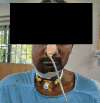Positive Outcomes of Physiotherapy in a Post-operative Case of Squamous Cell Carcinoma of Tongue and Buccal Mucosa Along With Transfemoral Amputation
- PMID: 38222148
- PMCID: PMC10784763
- DOI: 10.7759/cureus.50435
Positive Outcomes of Physiotherapy in a Post-operative Case of Squamous Cell Carcinoma of Tongue and Buccal Mucosa Along With Transfemoral Amputation
Abstract
Oral cancer is a type of malignant neoplasia that develops in the oral cavity or lips and is commonly referred to as squamous cell carcinoma (SCC) because of its histopathology. In this report, we present to you a case of a 35-year-old male patient operated on for moderately differentiated SCC of the lateral border of the tongue and right buccal mucosa with a two-year-old case of trans-femoral amputation. Postoperatively, the patient faced issues with breathing, mouth opening and closing limitations, and painful movements of the neck and right shoulder. An intensive physiotherapy care regimen was designed and consistently implemented for two weeks to tackle the surgical results that were compromising the patient's quality of life. At the two-week evaluation, enhancements in tongue movement, mouth opening, shoulder and cervical joint movement, thoracic mobility, lower limb strength, and gait were seen, confirming the efficacy of the intended therapy. The patient was assessed before and after the rehabilitation using range of motion, manual muscle testing, the Mallampati scale, the numerical pain rating scale, the amputee mobility predictor assessment tool, and the Royapettah scoring system.
Keywords: buccal mucosa; oral cancer; physical therapy; rehabilitation; tongue cancer; transfemoral amputation.
Copyright © 2023, Mandhane et al.
Conflict of interest statement
The authors have declared that no competing interests exist.
Figures
Similar articles
-
Importance of Cardiac Rehabilitation and Mouth Opening Exercises in Oral Squamous Cell Carcinoma: A Case Report.Cureus. 2023 Dec 22;15(12):e50954. doi: 10.7759/cureus.50954. eCollection 2023 Dec. Cureus. 2023. PMID: 38249192 Free PMC article.
-
Physiotherapy for Trismus Using Rocabado Exercises Following Mandibulectomy for Squamous Cell Carcinoma of the Lower Lip: A Case Report.Cureus. 2022 Nov 9;14(11):e31293. doi: 10.7759/cureus.31293. eCollection 2022 Nov. Cureus. 2022. PMID: 36514584 Free PMC article.
-
Management and Prognosis of Physical Therapy for the Post-Surgical Sequelae of Metastatic Cervical Lymphadenopathy.Cureus. 2022 Aug 4;14(8):e27673. doi: 10.7759/cureus.27673. eCollection 2022 Aug. Cureus. 2022. PMID: 36072191 Free PMC article.
-
Integral Role of Chest Physiotherapy and Proprioceptive Neuromuscular Facilitation in Improving the Oxygenation Index and Quality of Life of Patients With Squamous Cell Carcinoma: A Case Report.Cureus. 2025 Jan 26;17(1):e78009. doi: 10.7759/cureus.78009. eCollection 2025 Jan. Cureus. 2025. PMID: 40007924 Free PMC article.
-
Clinicopathological correlation of tumor-stroma ratio and inflammatory cell infiltrate with tumor grade and lymph node metastasis in squamous cell carcinoma of buccal mucosa and tongue in 41 cases with review of literature.J Cancer Res Ther. 2020 Apr-Jun;16(3):445-451. doi: 10.4103/0973-1482.193113. J Cancer Res Ther. 2020. PMID: 32719249 Review.
Cited by
-
The Role of Chest Physiotherapy in Enhancing Quality of Life in a Postoperative Patient With Gingivobuccal Sulcus Carcinoma and Empyema: A Case Report.Cureus. 2024 Sep 30;16(9):e70492. doi: 10.7759/cureus.70492. eCollection 2024 Sep. Cureus. 2024. PMID: 39479068 Free PMC article.
References
Publication types
LinkOut - more resources
Full Text Sources
Research Materials


